
Scotch whisky giant that steered the industry through dark periods and, through acquisitions and mergers, assumed virtual control of the Scotch whisky industry.
Founded in 1877 as a trade cartel to set prices for grain whiskies, Distillers Company Ltd. (DCL) grew into a controlling giant in the Scotch whisky industry, continually opening and closing distilleries in an attempt to match whisky supply with demand. While it never held a complete monopoly over the industry, and its name never appeared on a single label, the sheer size of its holdings ensured that it had a major influence on the industry as a whole.
DCL was formed in 1877 as an amalgamation of six Lowland grain whisky distilleries with the aim of allocating production in fixed proportions and setting prices for grain spirits. The founding companies were M. Macfarlane & Co, Glasgow (Port Dundas distillery), which replaced John Crabbie & Co’s Haddington distillery in earlier agreements; John Bald & Co, Alloa (Carsebridge distillery); John Haig & Co, Fife (firstly Seggie and then Cameronbridge distillery); McNab Bros & Co, Menstrie (Glenochil distillery); Robert Mowbray, Cambus (Cambus distillery); and Stewart & Co, Kirkliston (Kirkliston distillery).
The original six distilleries were joined in 1884 by Menzies & Co Ltd. (Caledonian distillery and a rectifying business in Tooley St., London) which had not joined in 1887, but had signed a formal agreement which foresaw eventual amalgamation with DCL. One of the strange things about the origins of DCL was that although the distilleries were now part of the same company, they continued to be operated by their original owners which still regarded their fellow directors as their main opposition.
By 1894 DCL was listed on the Edinburgh and Glasgow stock exchanges and, to meet demand from the John Haig & Co. business for Highland malt whisky, had built Knockdhu distillery near Banff. The Pattison crash of 1898 created an opportunity for DCL to control more of the industry through a programme of acquisitions (at knockdown prices) during the early part of the 1900s. One example was DCL's purchase of the Pattisons' bonded warehouses in Leith. These had cost the Pattison brothers an estimated £60,000 to build; DCL picked them up at auction for only £25,000.
The period before the First World War saw more consolidation in the Scotch whisky industry with DCL (sometimes with the assistance of other partners) picking up distilleries from the liquidators. Such was the scale of its strategy that by 1914 DCL claimed to be the ‘largest whisky distiller in the world’. To try and bring some order to the rapidly expanding company, DCL set up a subsidiary, Scottish Malt Distillers Ltd., to control the five Lowland distilleries that it either owned or had part shares in.
Despite DCL's ferocious acquisition trail, it was clear that the ‘Big Five’ producers – Haig, Buchanan’s, Dewar’s, Walker’s and Mackie’s (White Horse) – were still able to maintain their independence. The tight-knit group began to unravel though in 1919 when DCL purchased John Haig & Co. from the family, and John Walker & Sons and the newly merged Buchanan-Dewar joined DCL in 1925 on a share exchange basis. Two years later, after the death of Sir Peter Mackie, White Horse Distillers also joined the fold, creating a company that would control, but not monopolise, the Scotch whisky industry for the next 50 years.
In the 1970s UK sales were stagnating to the point that DCL, despite its large number of brands, was selling less whisky in its home market than Arthur Bell & Sons with its single line. Although Johnnie Walker was the best-selling Scotch in the world it was being challenged, and in 1985 James Gulliver’s Argyle group, which operated Fine Fare supermarkets and the Glen Scotia distillery, launched a hostile bid for the ‘hopelessly managed DCL’. The offer was rejected, and the group turned to brewer Guinness PLC, which had recently purchased Arthur Bell & Sons Ltd., as a ‘white knight’ and invited it to table a rival bid.
Although it was subsequently proven that Guinness had fraudulently funded its bid by inflating the price of its shares, by April 1986 the Guinness offer had been accepted and DCL was no more. The new company soon began a round of cost cutting exercises and the individual companies which had comprised DCL, soon began to lose their independence. Following a series of mergers and takeovers, Guinness and DCL evolved into today’s drinks giant, Diageo.
Excerpt from scotchwhisky.com
Further reading: https://www.encyclopedia.com/books/politics-and-business-magazines/distillers-company-plc
The Distillers Company
The Distillers Company